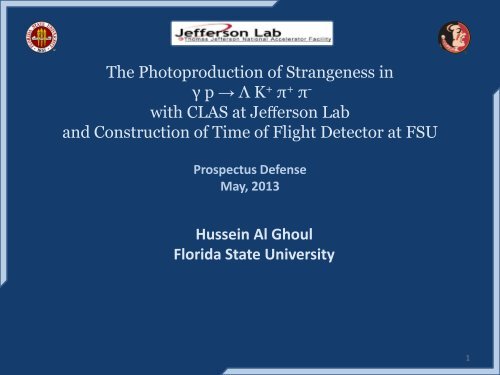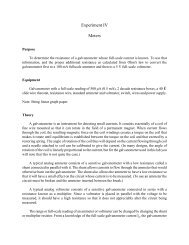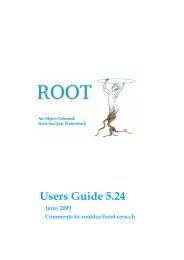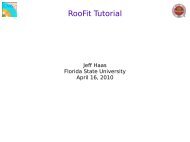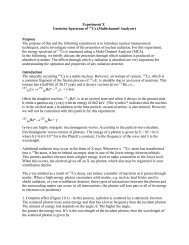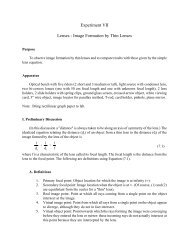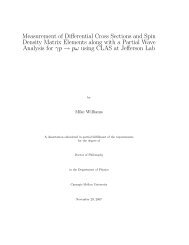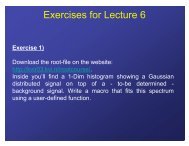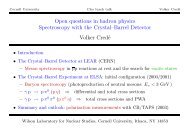CLAS g12 EXPERIMENT
CLAS g12 EXPERIMENT
CLAS g12 EXPERIMENT
Create successful ePaper yourself
Turn your PDF publications into a flip-book with our unique Google optimized e-Paper software.
The Photoproduction of Strangeness in<br />
γ p → Λ K + π + π -<br />
with <strong>CLAS</strong> at Jefferson Lab<br />
and Construction of Time of Flight Detector at FSU<br />
Prospectus Defense<br />
May, 2013<br />
Hussein Al Ghoul<br />
Florida State University<br />
1
Objectives<br />
‣ INTRODUCTION<br />
‣ MOTIVATION<br />
‣ <strong>CLAS</strong> <strong>g12</strong> <strong>EXPERIMENT</strong><br />
‣ ANALYSIS<br />
‣ GLUEX<br />
Hussein Al Ghoul, Prospectus Defense 2013<br />
2
Objectives<br />
‣ INTRODUCTION<br />
‣ MOTIVATION<br />
‣ <strong>CLAS</strong> <strong>g12</strong> <strong>EXPERIMENT</strong><br />
‣ ANALYSIS<br />
‣ GLUEX<br />
Hussein Al Ghoul, Prospectus Defense 2013<br />
3
Introduction<br />
‣ Quantum Chromodynamics And The Quark Model<br />
‣ Excited Strange Mesons<br />
Hussein Al Ghoul, Prospectus Defense 2013<br />
4
Quantum Chromodynamics And The Quark Model<br />
‣ Quantum Chromodynamics is the theory of strong interactions mediated by<br />
the “color” force.<br />
-Quarks are elementary particles , fermions, that make up all matter. Gluons are exchange<br />
particles, or gauge bosons, for the color force between quarks.<br />
- Baryons are half integer spin particles (fermions), while mesons are integer spin particles<br />
(bosons).<br />
- In the constituent Quark Model, a meson is made up of a quark-antiquark pair. A baryon is<br />
made up of three quarks.<br />
A Meson in the Quark Model<br />
A Baryon as “seen” by QCD<br />
Hussein Al Ghoul, Prospectus Defense 2013<br />
5
Excited Strange Mesons<br />
- Free quarks and gluons haven’t been seen in nature due to the confinement of<br />
quarks.<br />
- Different meson and baryon states are represented according to their total angular<br />
momentum J, the parity P, and the charge conjugation C.<br />
J = L + S<br />
P = (-1) L+1<br />
C = (-1) L+S<br />
allowed J PC = 0 -+ , 0 ++ ,1 -- ,1 +- . . .<br />
- QCD also predicts meson states that are beyond the constituent quark model<br />
(hybrids, glueballs, multi-quark states), these are called “Exotic Mesons”.<br />
exotic J PC = 0 -- , 0 +- ,1 -+ ,2 +- . . .<br />
Hussein Al Ghoul, Prospectus Defense 2013<br />
6
Excited Strange Mesons<br />
‣ In this research, we are looking for excited strange states through<br />
photoproduction. In particular the excited Kaon states.<br />
J PC = 0 - + J PC = 1 - - J PC = 1 - + 7<br />
Hussein Al Ghoul, Prospectus Defense 2013
Objectives<br />
‣ INTRODUCTION<br />
‣ MOTIVATION<br />
‣ <strong>CLAS</strong> <strong>g12</strong> <strong>EXPERIMENT</strong><br />
‣ ANALYSIS<br />
‣ GLUEX<br />
Hussein Al Ghoul, Prospectus Defense 2013<br />
8
Motivation<br />
‣ The γ p → p K + π + π - [π - ] reaction is an opportunity for searching for excited<br />
strange mesons.<br />
- Understand the photoproduction of a strange meson off a Λ strange baryon.<br />
- Preliminary results predict two decaying modes in the (K + π + π - ) system , that will be presented later<br />
on in this talk.<br />
Hussein Al Ghoul, Prospectus Defense 2013<br />
9
Objectives<br />
‣ INTRODUCTION<br />
‣ MOTIVATION<br />
‣ <strong>CLAS</strong> <strong>g12</strong> <strong>EXPERIMENT</strong><br />
‣ ANALYSIS<br />
‣ GLUEX<br />
Hussein Al Ghoul, Prospectus Defense 2013<br />
10
<strong>CLAS</strong> <strong>g12</strong> <strong>EXPERIMENT</strong><br />
- Jefferson Lab hosts CEBAF (Continuous Electron Beam Accelerator Facility) that<br />
delivers up to a 5.5 GeV photon beam to three halls: A, B and C.<br />
- Hall B hosts the CEBAF Large Acceptance Spectrometer (<strong>CLAS</strong>).<br />
Layout of CEBAF<br />
Layout of <strong>CLAS</strong><br />
Hussein Al Ghoul, Prospectus Defense 2013<br />
11
<strong>CLAS</strong> <strong>g12</strong> <strong>EXPERIMENT</strong><br />
- The <strong>g12</strong> experiment was primarily approved for exotic mesons and excited<br />
cascade states studies.<br />
- Up to a 5.5 GeV photon beam incident on a LH 2 target.<br />
- 26.2 billion triggers (68 Pb -1 , 126 TB) of various topologies.<br />
- About 25M γp → p K + π + π - [π - ] events.<br />
Hussein Al Ghoul, Prospectus Defense 2013<br />
12
Objectives<br />
‣ INTRODUCTION<br />
‣ MOTIVATION<br />
‣ <strong>CLAS</strong> <strong>g12</strong> <strong>EXPERIMENT</strong><br />
‣ ANALYSIS<br />
‣ GLUEX<br />
Hussein Al Ghoul, Prospectus Defense 2013<br />
13
ANALYSIS<br />
- The γp → p K + π + π - [π - ] events are selected from all the available data files.<br />
- About 24M γp → p K + π + π - [π - ] events.<br />
Description<br />
Events<br />
Selected from Data Files 24461620<br />
Timing and Vertex 4623235<br />
Beam Energy: E γ > 4.4 GeV 2045110<br />
Fitted Events 1176693<br />
5% Confidence Level Cut 397077<br />
Beta: P K < 1.85 GeV/c 186158<br />
Λ Selection 71488<br />
|t’|< 0.5 Gev 2 14980<br />
Hussein Al Ghoul, Prospectus Defense 2013<br />
14
Missing Pion Selection<br />
-Corrections applied in this part include: beam energy loss, particle energy loss and momentum corrections.<br />
Hussein Al Ghoul, Prospectus Defense 2013<br />
15
Selection of the Missing Pion and Kinematic Fitting<br />
- The missing mass is fit to a pion.<br />
- 5% confidence level cut is applied on the data.<br />
π - K -<br />
Hussein Al Ghoul, Prospectus Defense 2013<br />
16
Beta Cut<br />
Beta is the velocity of the particle.<br />
β = P/E<br />
Hussein Al Ghoul, Prospectus Defense 2013<br />
17
Selection of Λ<br />
Hussein Al Ghoul, Prospectus Defense 2013<br />
18
Intermediate States in the (K + π + π - ) System<br />
K*<br />
ρ<br />
K s<br />
K*(1410)?<br />
Hussein Al Ghoul, Prospectus Defense 2013<br />
19
Reduction of Baryon Background with t’ Cut<br />
Select events of t’ < 0.5 GeV 2 / c 4<br />
Σ(1385)<br />
Hussein Al Ghoul, Prospectus Defense 2013<br />
20
(K + π + π - ) System Study<br />
Hussein Al Ghoul, Prospectus Defense 2013<br />
21
What’s next?<br />
- Understand the baryon background and possibly including it in PWA.<br />
- Determine the cross section of (Λ K + π + π - ) and its upper limit.<br />
- A total of 15K Events were finally Selected, ready for PWA.<br />
Partial wave analysis of the (K + π + π - ) System will use decay amplitudes A α (τ)<br />
to study the contribution of various spin-parity states.<br />
Hussein Al Ghoul, Prospectus Defense 2013<br />
22
Objectives<br />
‣ INTRODUCTION<br />
‣ MOTIVATION<br />
‣ <strong>CLAS</strong> <strong>g12</strong> <strong>EXPERIMENT</strong><br />
‣ ANALYSIS<br />
‣ GlueX Experiment<br />
Hussein Al Ghoul, Prospectus Defense 2013<br />
23
GlueX Experiment At Jefferson Lab<br />
- An experiment targeted to search for exotic mesons.<br />
- Detector will be hosted in Hall D at Jefferson Lab, Virginia.<br />
- Expected to start taking data by 2014.<br />
ρ<br />
Fig 19. 12 GeV Upgrade to CEBAF.<br />
Fig 20. The GlueX detector.<br />
Hussein Al Ghoul, Prospectus Defense 2013<br />
24
Time of Flight (TOF) Detector<br />
- The GlueX detector is made of 6 sections: Superconducting<br />
solenoid, Start Counter, Barrel Calorimeter (BCAL), Central Drift<br />
Chamber (CDC), Forward Drift Chamber (FDC), and the Time of<br />
Flight (TOF), detector.<br />
- The time of flight detector is important for particles<br />
identification.<br />
- The Time of Flight section will be built here at FSU.<br />
- Consists of two planes of scintillator paddles each of which<br />
consists 44 bars per plane.<br />
- Each paddle is 2.5 m long, 6 cm wide, and 2.5 cm thick<br />
and is mounted by photomultipliers on opposite sides.<br />
- Scintillators and photomultipliers were tested.<br />
- Prototype modules were made.<br />
- A prototype was constructed.<br />
Fig 21. The TOF detector.<br />
Hussein Al Ghoul, Prospectus Defense 2013<br />
25
Conclusion and Future Plans<br />
- The chosen channel has shown to be convenient for studying the<br />
photoproduction of strange mesons.<br />
- All data files have been processed and all corrections were<br />
performed.<br />
- The final decay modes of the (K + π + π - ) system are expected to be the<br />
(K * π + ) and the (ρ K + ).<br />
- Partial Wave Analysis will start shortly.<br />
- Study the Cross Section of the (Λ K + π + π - ) System.<br />
- Construct the final TOF modules.<br />
Hussein Al Ghoul, Prospectus Defense 2013<br />
26
Thank You!<br />
Hussein Al Ghoul, Prospectus Defense 2013<br />
27


